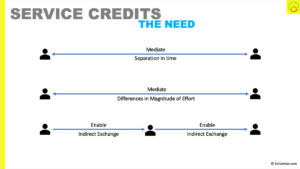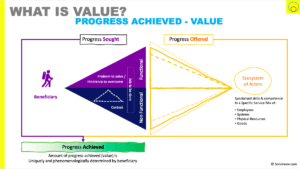There are 68 search results for: open innovation
Cash is everywhere - but what role does it have as we try and look at the economy as service-exchange based?
This is a preliminary view, where I look at cash rather than as a proxy for value, as being service tokens, which supports:
- mediation of temporal and magnitude differences in a service exchange
- enables indirect service exchange
Such a view still allows us to observe common aspects of cash (the desire to acquire as much as possible).
And allows us to maintain our improved view of value - relating to progress being made. In addition to service-service continuum and other behavioural quirks we see.
The service mix helps us avoid myopia in innovation and gives us the framework to see what components we can mix between in our efforts to help beneficiaries make progress.
It is part of our definition of service, and comprises:
- employees
- physical resources
- goods
- systems
that the ecosystem offering the value proposition decides to provide
Here's a description of the Lean Canvas - a one-page business plan
We can use it to neatly describe an innovation. As well as guide-rails for an innovator to take an idea to an innovation description.
There is a criticism that the original 4P marketing mix doesn't address service. Which comes from a view that service and goods are fundamentally different.
To address this criticism, Boom & Bitner introduced 3 additional Ps to derive the Service Marketing Mix. These new Ps are People, Physical Evidence and Process.
Kotler added an 8th - performance. And this is sometimes altered to partnership
Product, Price, Promotion and Place. These are the 4Ps of the original marketing mix. Which helps us tease out things we need to think of to sell our product
It's a marketing classic - but with lots of criticism. Which are sometimes not well looked into by marketing, business or MBA courses.
A value proposition details how the offer will help a beneficiary make progress.
I've defined this as the proposed value (whereas realised value is the amount of value co-created)
We can use a formula way to describe a value proposition:
- I (beneficiary)
- who (functional progress being sought [job to be done, hindrance to avoid, problem to solve])
- the (product/brand name) is a (product category)
- that (functional and non functional progress offered)
- unlike (primary competitor alternatives), (product/brand name) (primary differentiation statement).
Value - it's more than the price someone is prepared to pay
It is the proposal to help a beneficiary make functional and/or non-functional progress in some aspect of their life. And it is the amount of progress made in use (co-creation of value).
That we measure value today by price paid and/or volume sold is a result of our product-dominant logic view of the world. It turns out, these are proxies we end up using as we are not relational enough. Something service-dominant logic opens our eyes up to.









